Installing M&E systems on flat roofs is challenging enough, but what if the roof or surface you are fixing to has a pitch or slope? It’s important that services are installed level to ensure safe and proper functioning of the equipment.
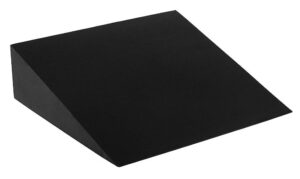
Basic wedge for set pitch
This presents challenges for fixing the M&E services using standard rooftop support feet as the majority are designed to sit on a flat surface. The most common solution offered is that of a rubber wedge to place under the support foot, which is fine if the pitch of the roof slope matches the pitch of the wedge, but is otherwise a quite inflexible solution!
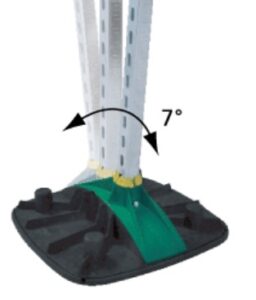
Fully adjustable Walraven Yeti 480
That’s why we developed our Walraven Yeti 480 foot, to deliver an all-in-one solution with easy adjustment and plenty of added benefits. With no additional parts required, simply tilt the adjustable mid-section to the required pitch and tighten with the allen key provided. This makes it fast, accurate and incredibly easy to install.
The Walraven Yeti 480’s design includes features that facilitate precise alignment of M&E systems on pitched roofs. Installers can easily adjust the product to match the roof’s slope, guaranteeing optimal alignment regardless of the degree of pitch (0-7°).
In the following section we will explore the wider challenges of fixing on a rooftop, whether pitched or flat, and how the Yeti® 480 offers a complete, advanced solution all-in-one.
Both flat and pitched roofs pose a number of challenges to be addressed when looking to install M&E services. Walraven Yeti feet provide a reliable, simple solution to address all of these issues.
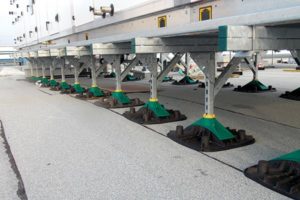 This must be considered prior to installation to ensure it is not compromised with the chosen solution. One of the key factors relating to this is ensuring suitable load distribution of the installation. Every rooftop surface has its own deformation rating, how much load can be safely applied to the surface, until penetration. This will determine the number and placement of roof support feet required.
This must be considered prior to installation to ensure it is not compromised with the chosen solution. One of the key factors relating to this is ensuring suitable load distribution of the installation. Every rooftop surface has its own deformation rating, how much load can be safely applied to the surface, until penetration. This will determine the number and placement of roof support feet required.
Walraven Yeti® feet can provide optimised load distribution for up to very high loads and our technical team can help you determine the number of feet required for the optimal solution.
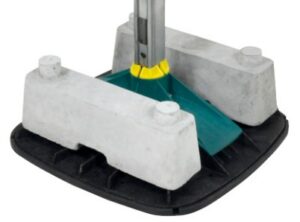 Different surfaces will have a different coefficient of friction. This means that the resistance to motion between the rubber support feet and the roof surface can differ. Therefore, a suitable solution must be chosen to ensure that the installation is stable and does not move or slide on the surface.
Different surfaces will have a different coefficient of friction. This means that the resistance to motion between the rubber support feet and the roof surface can differ. Therefore, a suitable solution must be chosen to ensure that the installation is stable and does not move or slide on the surface.
Walraven Yeti® 480 feet come with a non-slip mat as standard which is compatible with most common surface types. In addition, ballast blocks can be used to provide extra stability if required.
If you’re installing HVAC equipment on a rooftop, this can often result in noise and vibration which can pass through the building structure and cause potentially severe problems. In some cases anti-vibration products such as spring mounts may also be required, but the rooftop support feet can also help towards combatting problematic noise and vibration.
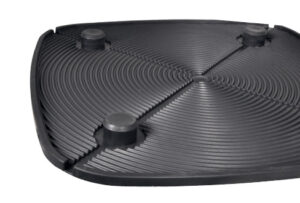 As most rooftop feet are made of rubber, they provide some ‘natural’ level of vibration and noise resistance, but in most cases this cannot be quantified or guaranteed because the product has not been tested and certified for this. So if there is a particular concern regarding noise on your build, you might need to look carefully for a certified solution like Walraven’s Yeti® 480.
As most rooftop feet are made of rubber, they provide some ‘natural’ level of vibration and noise resistance, but in most cases this cannot be quantified or guaranteed because the product has not been tested and certified for this. So if there is a particular concern regarding noise on your build, you might need to look carefully for a certified solution like Walraven’s Yeti® 480.
Walraven Yeti® 480 feet not only include an integrated anti-vibration mat, they are the only rooftop support feet that have received third party testing and certification for noise reduction. They were tested according to DIN EN ISO 10140-1 and DIN EN ISO 10140-3 up to 31 dB(A).
When installing on an exposed rooftop, it is critical to take into account the effect that different weather conditions will have on the installation. For example, wind and snow loads need to be considered when looking at the overall rooftop load capacity.
UV rays can cause serious degradation to plastic and rubber elements of a rooftop installation, such as the plastic or rubber support feet. This could seriously limit the lifetime of the installation if the feet used do not have any UV resistant properties.
Walraven Yeti® 480 feet have been tested and certified by ITB for UV resistance according to EN ISO 16474-3:2014-02. So you can be confident that they will deliver a long lifespan.
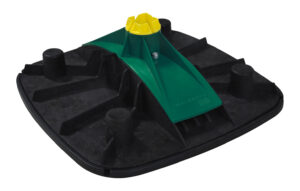 If environmental considerations are important on your project, you will want to use products that help you deliver more sustainable installations, or meet any requirements specified in the building design documents. Most rooftop support feet are made of rubber or plastic. Manufacturers should be able to tell you if they are made of recycled materials or not, be aware that not all will be. So if this is an important requirement for your project you should enquire with the manufacturer.
If environmental considerations are important on your project, you will want to use products that help you deliver more sustainable installations, or meet any requirements specified in the building design documents. Most rooftop support feet are made of rubber or plastic. Manufacturers should be able to tell you if they are made of recycled materials or not, be aware that not all will be. So if this is an important requirement for your project you should enquire with the manufacturer.
Walraven Yeti® 480 feet are made of WPC which is a recycled plastic and wood fibre composite and can be recycled or reused at the end of their lifespan.
See why it was used on the recent Everton Stadium build in our online case study.
Visit our Walraven Yeti page to find out more and see a video demonstration of the product.